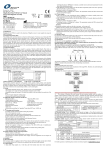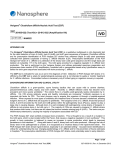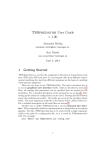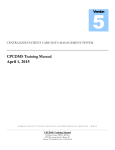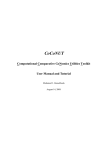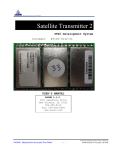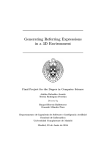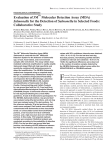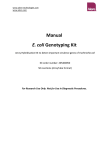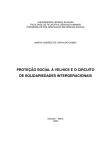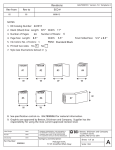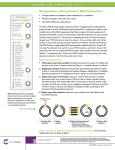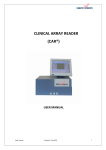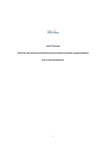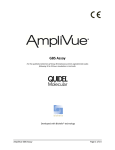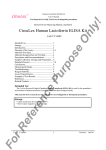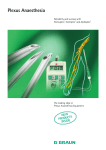Download Revisions - BD Molecular Diagnostics
Transcript
Revisions Rev from Rev to ECO # N/A 01 N/A BALTSO0191 Version 7.0 Template 4 NOTES: 1. BD Catalog Number: 443378 2. Blank (Sheet) Size: Length: 13” 3. Number of Pages: 24 4. Page Size: Length: 13” Number of Sheets: 6 No 7. Style (see illustrations below): # 5 W Final Folded Size: 11” x 5.5” (Document is set up PMS # 2755, Standard Black as 13” x 8.5” but printed booklet style on 11” x 8.5” paper.) Width: 5. Ink Colors: No. of Colors: 2 6. Printed two sides: Yes X Width: 8.5” W 8.5” W W W W W 8. See specification control no. N/A for material information. 9. Graphics are approved by Becton, Dickinson and Company. Supplier has the responsibility for using the most current approved revision level. Label Design Date Proofer Date Checked By N/A Date Part Number: P0166 COMPANY CONFIDENTAL. THIS DOCUMENT IS THE PROPERTY OF BECTON, DICKINSON AND COMPANY AND IS NOT TO BE USED OUTSIDE THE COMPANY WITHOUT WRITTEN PERMISSION. N/A Category and Description Package Insert, BD MAX Enteric Bacterial Panel - US Kit Becton, Dickinson and Company 7 Loveton Circle Sparks, MD 21152 USA Sheet: 1 of 25 Scale: N/A A BD MAX™ Enteric Bacterial Panel For In Vitro Diagnostic Use For use with the BD MAX™ System 443378 P0166(01) 2014-05 Rx Only INTENDED USE The BD MAX™ Enteric Bacterial Panel performed on the BD MAX™ System is an automated in vitro diagnostic test for the direct qualitative detection and differentiation of enteric bacterial pathogens. The BD MAX Enteric Bacterial Panel detects nucleic acids from: Salmonella spp. Campylobacter spp. (jejuni and coli) Shigella spp. / Enteroinvasive E. coli (EIEC) Shiga toxin 1 (stx1) / Shiga toxin 2 (stx2) genes (found in Shiga toxin-producing E. coli [STEC]) as well as Shigella dysenteriae, which can possess a Shiga toxin gene (stx) that is identical to the stx1 gene of STEC. Testing is performed on unpreserved soft to diarrheal stool specimens or Cary-Blair preserved stool specimens from symptomatic patients with suspected acute gastroenteritis, enteritis or colitis. The test is performed directly on the specimen, utilizing real-time polymerase chain reaction (PCR) for the amplification of SpaO, a Campylobacter specific tuf gene sequence, ipaH and stx1/stx2. The test utilizes fluorogenic sequence-specific hybridization probes for detection of the amplified DNA. This test is intended for use, in conjunction with clinical presentation, laboratory findings, and epidemiological information, as an aid in the differential diagnosis of Salmonella, Shigella/EIEC, Campylobacter and Shiga toxin-producing E. coli (STEC) infections. Results of this test should not be used as the sole basis for diagnosis, treatment, or other patient management decisions. Positive results do not rule out co-infection with other organisms that are not detected by this test, and may not be the sole or definitive cause of patient illness. Negative results in the setting of clinical illness compatible with gastroenteritis may be due to infection by pathogens that are not detected by this test or non-infectious causes such as ulcerative colitis, irritable bowel syndrome, or Crohn’s disease. SUMMARY AND EXPLANATION OF THE PROCEDURE Organisms that cause enteric diseases represent a significant cause of morbidity and mortality worldwide. Enteric infections enter the body through the gastrointestinal tract and typically are spread via contaminated food and water or contact with vomit or feces. CDC estimates there are 48 million cases of foodborne illness in the United States each year resulting in 128,000 hospitalization and 3,000 deaths.1 In the developing world, these illnesses cause approximately 2 million deaths annually in young children.2 Each of the causative agents may result in slightly different symptomology, including abdominal cramps or pain, loss of appetite, nausea or vomiting; however, all result in diarrhea.3 Repeated bouts of diarrhea and persistent diarrheal disease disrupt intestinal function and absorption, potentially leading to childhood malnutrition and growth retardation.4 Although the most common gram-negative enteric bacterial agents are easily cultivated on standard selective and differential media with toxin detection by antibody mediated lateral flow, isolation and identification are time consuming. Diagnosis may take several days, which places patients at risk for an untreated infection as well as the spread of the infection to others. Alternatively, empirical antimicrobial therapy may have severe consequences for some enteric bacterial infections, such as those caused by Shiga toxin-producing E. coli (STEC) potentially leading to fatal complications known as hemolytic uremic syndrome in children.5 In persons with compromised immune systems, Campylobacter and Salmonella infections occasionally spread to the bloodstream and cause a serious life-threatening infection.6,7 P0166(01) The BD MAX Enteric Bacterial Panel procedure can be performed in approximately 3 hours, as compared to traditional culture methods which can take 48 to 96 hours. The BD MAX Enteric Bacterial Panel simultaneously detects the pathogens responsible for gastreoenteritis due to Salmonella spp., Campylobacter spp. (jejuni and coli), Shigella spp./ EIEC, and stx1/stx2 found in Shiga toxin-producing E. coli. The assay includes an internal Sample Processing Control (SPC). The BD MAX Enteric Bacterial Panel automates the testing process and minimizes operator intervention from the time the sample is placed onto the BD MAX System until results are available. A soft to diarrheal stool is collected and transported to the laboratory, homogenized and looped into a BD MAX™ Enteric Bacterial Panel Sample Buffer Tube (SBT). The Sample Buffer Tube is placed into the BD MAX™ System and the following automated procedures occur: The bacterial cells are lysed, DNA is extracted on magnetic beads and concentrated, and then an aliquot of the eluted DNA is added to PCR reagents which contain the target-specific primers used to amplify the genetic targets, if present. The assay also includes a Sample Processing Control (SPC). The SPC is present in the Extraction Tube and undergoes the extraction, concentration and amplification steps to monitor for inhibitory substances, instrument or reagent failure. No operator intervention is necessary once the clinical sample and reagent strip are loaded into the BD MAX™ System. The BD MAX™ System automates sample lysis, DNA extraction and concentration, reagent rehydration, nucleic acid amplification and detection of the target nucleic acid sequence using real-time polymerase chain reaction (PCR). Amplified targets are detected with hydrolysis probes labeled with quenched fluorophores. The amplification, detection and interpretation of the signals are done automatically by the BD MAX™ System. PRINCIPLES OF THE PROCEDURE Stool specimens are collected from patients and transported to the laboratory unpreserved in a clean container or preserved in Cary-Blair transport media. A 10 µL loop is inserted to the depth of the loop into the specimen, and expressed via a swirling motion into a BD MAX Sample Buffer Tube (SBT). The SBT is closed with a septum cap and vortexed. Once the work list is generated and the clinical sample is loaded on the BD MAX instrument, along with a BD MAX Enteric Bacterial Panel Unitized Reagent Strip and PCR Cartridge, the run is started and no further operator intervention is required. The BD MAX System automates sample preparation, including target organism lysis, DNA extraction and concentration, reagent rehydration, target nucleic acid sequence amplification and detection using real-time PCR. The interpretation of the signal is performed automatically by the BD MAX System. The assay also includes an SPC that is provided in the Extraction Tube and subjected to extraction, concentration and amplification steps. The SPC monitors for the presence of potential inhibitory substances as well as system or reagent failures. Following enzymatic cell lysis at an elevated temperature, the released nucleic acids are captured on magnetic affinity beads. The beads, with the bound nucleic acids, are washed and the nucleic acids are eluted. Eluted DNA is neutralized and transferred to the Master Mix Tube to rehydrate the PCR reagents. After rehydration, the BD MAX System dispenses a fixed volume of PCR-ready solution into the BD MAX PCR Cartridge. Microvalves in the BD MAX PCR Cartridge are sealed by the system prior to initiating PCR to contain the amplification mixture thus preventing evaporation and contamination. The amplified DNA targets are detected using hydrolysis (TaqMan®) probes, labeled at one end with a fluorescent reporter dye (fluorophore) and at the other end with a quencher moiety. Probes labeled with different fluorophores are used to detect amplicons for enteric bacterial targets (Campylobacter specific tuf17 gene sequence variants, the SpaO16 gene for specific detection of Salmonella spp., the ipaH9,10 gene for specific detection of Shigella spp. or Enteroinvasive E. coli (EIEC), the stx1 & stx2 genes8 associated with production of Shiga toxins in STEC and S. dysenteriae) and the SPC in five different optical channels of the BD MAX System. When the probes are in their native state, the fluorescence of the fluorophore is quenched due to its proximity to the quencher. However, in the presence of target DNA, the probes hybridize to their complementary sequences and are hydrolyzed by the 5’-3’ exonuclease activity of the DNA polymerase as it synthesizes the nascent strand along the DNA template. As a result, the fluorophores are separated from the quencher molecules and fluorescence is emitted. The BD MAX System monitors these signals at each cycle and interprets the data at the end of the program to report the final results. 2 REAGENTS AND MATERIALS REF 443378 Contents BD MAX Enteric Bacterial Panel Master Mix (B5) Oven-dried PCR Master Mix containing TaqMan specific molecular probe and primers along with Sample Processing Control-specific TaqMan probe and primers. BD MAX Enteric Bacterial Panel Reagent Strips Unitized reagent strip containing all the liquid reagents and disposable pipette tips necessary for DNA Extraction. BD MAX Enteric Bacterial Panel Extraction Tubes (B2) Oven-dried pellet containing DNA magnetic affinity beads, protease reagents and Sample Processing Control. BD MAX Enteric Bacterial Panel Sample Buffer Tubes Septum Caps Quantity 24 tests 24 tests 24 tests 24 tests 25 EQUIPMENT AND MATERIALS REQUIRED BUT NOT PROVIDED • • • • • • • BD MAX PCR Cartridges (BD, Cat. No. 437519) VWR Multi-Tube Vortex Mixer (VWR, Cat. No. 58816-115) Vortex Genie 2 (VWR, Cat. No. 58815-234) or equivalent Nalgene® Cryogenic Vial Holder (VWR, Cat. No. 66008-783) Rack compatible with a multi-tube vortex mixer (e.g., Cryogenic Vial Holder or equivalent) Disposable 10 µL inoculating loops (BD, Cat. No. 220216) Lab coat and powderless disposable gloves For “Unpreserved” Stool Specimen types: • Dry, clean containers for the collection of liquid or soft stool samples For “Preserved” Stool Specimen types: • Cary-Blair transport media (15 mL) Suggested Media for Cultivation of Control Isolates (see Quality Control Section): • Trypticase Soy Agar with 5% Sheep Blood (For Salmonella, Shigella and E. coli) (e.g., BBL™ Trypticase™ Soy Agar with 5% Sheep Blood [TSA II], BD, Cat. No. 221292) • Brucella Agar with 5% Sheep Blood, Hemin & Vitamin K1 (For Campylobacter jejuni) (e.g., BBL™ Brucella Agar with 5% Sheep Blood, Hemin and Vitamin K1, BD, Cat. No. 297848) WARNINGS AND PRECAUTIONS • • • • • • • • • • • • • State and local public health authorities have published guidelines for notification of reportable diseases in their jurisdictions including but not limited to Salmonella, Shigella, and Shiga toxin (stx1/stx2) producing E. coli (STEC) to determine necessary measures for verification of results to identify and trace outbreaks. Laboratories are responsible for following their state or local regulations for submission of clinical material or isolates on positive specimens to their state public health laboratories. The BD MAX Enteric Bacterial Panel is for in vitro Diagnostic Use. This product can only be used on the BD MAX System. Do not use the kit if the label that seals the outer box is broken. Do not use reagents if the protective pouches are open or broken upon arrival. Close protective pouches of reagents promptly with the zip seal after each use. Remove any excess air in the pouches prior to sealing. Check reagent strips for proper liquid fills (ensure that the liquids are at the bottom of the tubes) (see Figure 1). Check reagent strips to ensure that all pipette tips are present (see Figure 1). Do not remove desiccant from reagent pouches. Do not use reagents if desiccant is not present or is broken inside reagent pouches. Do not use reagents if the foil has been broken or damaged. Do not mix reagents from different pouches and/or kits and/or lots. Do not interchange or reuse caps, as contamination may occur and compromise test results. 3 • • • • • • • • • • • • • • • Proceed with caution when using chemical solutions as Master Mix and Extraction Tube barcode readability may be altered. Do not use expired reagents and/or materials. Good laboratory technique is essential to the proper performance of this assay. Due to the high analytical sensitivity of this test, extreme care should be taken to preserve the purity of all materials and reagents. To avoid contamination by amplicons, do not break apart the BD MAX PCR Cartridges after use. The seals of the BD MAX PCR Cartridges are designed to prevent contamination. BD MAX PCR Cartridges may be used for up to two runs. Performing the BD MAX Enteric Bacterial Panel outside the recommended time ranges can produce invalid results. Assays not performed within the specified time ranges should be repeated with a new specimen. Additional controls may be tested according to guidelines or requirements of local, state, provincial and/or federal regulations or accrediting organizations. In cases where culture or other PCR tests are conducted in the laboratory, care must be taken to ensure that the BD MAX Enteric Bacterial Panel, any additional reagents required for testing, and the BD MAX System are not contaminated. Avoid microbial and deoxyribonuclease (DNase) contamination of reagents at all times. Gloves must be changed before manipulating reagents and cartridges. Always handle specimens as if they are infectious and in accordance with safe laboratory procedures such as those described in the CLSI Document M2911 and in Biosafety in Microbiological and Biomedical Laboratories.12 Wear protective clothing and disposable gloves while handling all reagents. Wash hands thoroughly after performing the test. Do not pipet by mouth. Do not smoke, drink, chew or eat in areas where specimens or kit reagents are being handled. Dispose of unused reagents and waste in accordance with local, state, provincial and/or federal regulations. Consult the BD MAX System User’s Manual13 for additional warnings, precautions and procedures. STORAGE AND STABILITY Collected specimens, either unpreserved stool or stool stored in 15 mL Cary-Blair transport media, should be kept between 2 °C and 25 °C during transport. Protect against freezing or exposure to excessive heat. Specimens can be stored for up to 5 days at 2-8 °C or for up to 24 h at 2-25 °C before testing. BD MAX Enteric Bacterial Panel components are stable at 2-25 °C through the stated expiration date. Do not use expired components. BD MAX Enteric Bacterial Panel Master Mix and Extraction Tubes are provided in sealed pouches. To protect product from humidity, immediately re-seal after opening. Reagent Tubes are stable for up to 14 days at 2-25 °C after initial opening and re-sealing. INSTRUCTIONS FOR USE Specimen Collection/Transport In order to obtain an adequate sample, the procedure for sample collection must be followed closely. Using a dry, clean container, liquid or soft stool samples are collected according to the following procedure: 1. Unpreserved specimens: Transfer liquid or soft stool samples to a dry, clean container. Avoid contamination with water or urine. Label the container and transport to the laboratory according to institutional standard operating procedures (Refer to the Storage and Stability section). Avoid mixing toilet paper, water or soap with the sample. 2. Cary-Blair preserved specimens: Transfer liquid or soft stool samples to a 15 mL transport device according to the manufacturer’s instructions. Avoid contamination with water or urine and avoid mixing toilet paper or soap with the sample. Label the container and transport to the laboratory according to institutional standard operating procedures (Refer to the Storage and Stability section). 4 Sample Preparation NOTE: One (1) Sample Buffer Tube (SBT), one (1) Septum Cap, one (1) Master Mix, one (1) Extraction Tube and one (1) Unitized Reagent Strip are required for each sample and each External Control to be tested. Set aside the required number of materials from their protective pouches or boxes. To store opened Master Mix or Extraction Tube pouches, remove excess air and close using the zip seal. 1. Label a bar-coded BD MAX SBT (clear cap) with the appropriate sample identification. Do not obscure, write or label over the 2D-barcode. 2. Vortex unpreserved or Cary-Blair preserved samples at high speed for 15 seconds. 3. Remove the clear cap from the SBT and inoculate as follows: a. Insert a 10 μL disposable inoculation loop until the entire loop portion is submerged in the sample. Do not insert beyond the loop as any additional stool on the shaft can overload the PCR reaction; b. Insert the loaded loop into the SBT and express the sample using a swirling motion. NOTE: Removal of the entire sample from the loop is not necessary. The resultant SBT solution should be “tea-stained” in color. 4. Recap the inoculated SBT using a Septum Cap. 5. Place the SBT in a rack compatible with a multi-tube vortex mixer, if available (e.g., cryogenic vial holder or equivalent). 6. Prepare any additional samples for testing by repeating Steps 1 through 5, ensuring gloves are clean prior to handling additional specimens. 7. Vortex all prepared samples simultaneously at maximum speed for one (1) min with the multi-tube vortex mixer. 8. Proceed to BD MAX System Operation section to perform testing of the BD MAX Enteric Bacterial Panel on the BD MAX System. BD MAX System Operation NOTE: Refer to the BD MAX System User’s Manual for detailed instructions (Operation section). NOTE: Testing of the BD MAX Enteric Bacterial Panel must be performed immediately after the vortexing step above (Sample Preparation, Step 7). If retesting is necessary, re-vortex sample(s). 1. Power on the BD MAX System (if not already done) and log in by entering <user name> and <password>. 2. Gloves must be changed before manipulating reagents and cartridges. 3. Remove the required number of Unitized Reagent Strips from the BD MAX Enteric Bacterial Panel kit. Gently tap each strip onto a hard surface to ensure that all liquids are at the bottom of the tubes. 4. Remove the required number of Extraction Tube(s) and Master Mix Tube(s) from their protective pouches. Remove excess air, and close pouches with the zip seal. 5. For each specimen to be tested, place one (1) Unitized Reagent Strip on the BD MAX System Rack, starting with Position 1 of Rack A. 6. Snap one (1) Extraction Tube (white foil) into each Unitized Reagent Strip in Position 1 as shown in Figure 1. 7. Snap one (1) Master Mix Tube (green foil) into each Unitized Reagent Strip in Position 2 as shown in Figure 1. Figure 1: Snap BD MAX Enteric Bacterial Extraction Tubes and Master Mix Tubes into reagent strips 8. Click on the Run icon and enter the kit lot number for the BD MAX Enteric Bacterial Panel (for lot traceability) by either scanning the barcode with the scanner or by manual entry. NOTE: Repeat step 8 each time a new kit lot is used. 5 9. Navigate to the Worklist. Using the pull down menu select <BD MAX Ent Bac>. 10. Enter the Sample Buffer Tube ID, Patient ID and Accession Number (if applicable) into the Worklist, either by scanning the barcode with the scanner or by manual entry. 11. Select the appropriate kit lot number (found on the outer box) from the pull down menu. 12. Repeat steps 9 to 11 for all remaining SBTs. 13. Place the SBTs in the BD MAX System Rack(s) corresponding to the Unitized Reagent Strips assembled in steps 5 to 7. NOTE: Place the tubes in the sample rack(s) with the 1D barcode labels facing outward (this makes scanning sample tubes easier during sample login. 14. Place the required number of BD MAX PCR Cartridge(s) into the BD MAX System (see Figure 2). • Each cartridge accommodates 2 runs of up to 12 samples for a total of 24 samples. • The BD MAX System will automatically select the position and row on the PCR Cartridge for each run. • PCR Cartridges are used on a per-run AND rack basis (2 runs per cartridge and 1 cartridge per rack). Figure 2: Load BD MAX PCR Cartridges 15. Load rack(s) onto the BD MAX System (Figure 3). Side A Side B Figure 3: Load Rack(s) onto the BD MAX System. 16. Close the BD MAX System lid and click <Start> to begin processing. 17. At the end of the run, check results immediately or store SBTs at 2-8 °C for up to 5 days OR at 25 ± 2 °C for a maximum of 48 h until the results are checked. NOTE: If a septum cap was damaged during the run, replace it with a new one before storing the sample. NOTE: Prepared BD MAX Enteric Bacterial Panel Sample Buffer Tubes can be stored at 2-8 °C for a maximum of 120 h (5 days) OR at 25 ± 2 °C for a maximum of 48 h after the sample has been added to the Sample Buffer Tubes. When an Indeterminate (IND), Unresolved (UNR), or Incomplete (INC) result is obtained, or when an External Control failure occurs, a repeat test from the prepared Sample Buffer Tube must be performed within this timeframe (see the Repeat Test Procedure section). 6 QUALITY CONTROL Quality control procedures monitor the performance of the assay. Laboratories must establish the number, type and frequency of testing control materials according to guidelines or requirements of local, provincial, state and/or federal regulations or accreditation organizations. For general QC guidance, the user may wish to refer to CLSI MM03 and C24.14,15 The procedure described below may be employed, if appropriate, based on local policies and procedures. 1. External Positive and Negative Controls are not used by the BD MAX System software for the purpose of sample test result interpretation. External Controls are treated as if they were patient samples. (Refer to Table 1 for the interpretation of External Control assay results.) 2. One (1) External Positive Control and one (1) External Negative Control should be run at least daily until adequate process validation is achieved on the BD MAX System in each laboratory setting. Reduced frequency of control testing should be in accordance with applicable regulations. 3. The External Positive Control is intended to monitor for substantial reagent failure. The External Negative Control is used to detect reagent or environmental contamination (or carry-over) by target nucleic acids. 4. Control strains should be tested according to guidelines or requirements of local, state, provincial and/or federal regulations or accreditation organizations in order to monitor the effectiveness of the entire analytical process. Various types of external controls are recommended to allow the user to select the most appropriate for their laboratory quality control program. 5. Suspension(s) of QC bacterial strains from commercially available sources such as the ATCC™ can be used for QC purposes. The External Control strains listed below or previously characterized samples known to be positive or negative for the gene targets found in the BD MAX Enteric Bacterial Panel can be used: a. External Positive Control: prepare a suspension of the following ATCC strains: • Salmonella enterica subsp. enteric serovar Typhimurium (ATCC 14028) containing the SpaO gene target. • Shigella sonnei (ATCC 9290) containing the ipaH gene target. • E. coli, stx1 (ATCC 43890) containing the stx1 gene target. • Campylobacter jejuni subsp. jejuni (ATCC 33291) containing the Campylobacter specific tuf gene sequence variants. b. External Negative Control: Express a 10 μL loop of saline in the SBT. For Salmonella, Shigella and E. coli, inoculate organisms onto Trypticase Soy Agar with 5% Sheep Blood plates. Incubate 18-24 h in ambient conditions. For Campylobacter jejuni, inoculate onto Brucella Agar with 5% Sheep Blood, Hemin and Vitamin K1. Incubate 2-3 days in a microaerophilic environment, or until there is sufficient growth to prepare the McFarland dilution. All plates must be prepared fresh daily. For preparation of the External Positive Control, re-suspend individual isolates in saline solution to a turbidity of 0.5 McFarland (~1 X 108 CFU/mL). Perform serial dilutions with saline to obtain a suspension of ~1.0 X 106 CFU/mL (for Salmonella spp., Shigella spp., or E. coli organisms) or ~1.0 X 105 CFU/mL (for Campylobacter spp.). Inoculate a SBT with a 10 µL loop of the bacterial suspension. Process and test as a sample (refer to the Sample Preparation and BD MAX System Operation sections). All external controls should yield the expected results [positive for External Positive Control, negative for External Negative Control and no failed external controls (Unresolved or Indeterminate results)]. Alternate culture storage conditions should be validated by individual laboratories as appropriate. 6. An External Negative Control that yields a positive test result is indicative of a sample handling and/or contamination problem. Review the sample handling technique to avoid mix-up and/or contamination. An External Positive Control that yields a negative result is indicative of a sample handling/preparation problem. Review the sample handling/preparation technique. 7. An External Control that yields an Unresolved, Indeterminate or Incomplete test result is indicative of a reagent or a BD MAX System failure. Check the BD MAX System monitor for any error messages. Refer to the System Error Summary section of the BD MAX System User’s Manual for interpretation of warning and error codes. If the problem persists, use reagents from an unopened pouch or use a new BD MAX Enteric Bacterial Panel. 8. Each BD MAX Enteric Bacterial Extraction Tube contains a Sample Processing Control (SPC) which is a plasmid containing a synthetic target DNA sequence. The SPC monitors the efficiency of DNA capture, washing and elution during the sample processing steps, as well as the efficiency of DNA amplification and detection during PCR analysis. If the SPC result fails to meet the acceptance criteria, the result of the sample will be reported as Unresolved; however, any positive (POS) assay results will be reported and no targets will be called NEG. An Unresolved result is indicative of sample-associated 7 inhibition or reagent failure. Repeat any sample reported as Unresolved according to the Repeat Test Procedure section below. RESULTS INTERPRETATION Results are available on the <Results> tab in the <Results> window on the BD MAX System monitor. The BD MAX System software automatically interprets test results. Results are reported for each of the analytes and for the Sample Processing Control. A test result may be called NEG (Negative), POS (Positive) or UNR (Unresolved) based on the amplification status of the target and of the SPC. IND (Indeterminate) or INC (Incomplete) results are due to BD MAX System failure. In the case of a partial UNR, where one or more targets have a POS result and all other targets have a UNR result, no targets will be called NEG. Table 1: BD MAX Enteric Bacterial Panel Result Interpretation ASSAY RESULT REPORTED INTERPRETATION OF RESULT* Shig POS Shigella spp. / EIEC DNA Detected1, 2 Shig NEG No Shigella spp. / EIEC DNA Detected STX POS Shiga toxin-producing gene(s) Detected1, 3 STX NEG No Shiga toxin-producing gene(s) Detected Campy POS Campylobacter spp. (jejuni or coli) DNA Detected Campy NEG No Campylobacter spp. (jejuni and coli) DNA Detected Salm POS Salmonella spp. DNA Detected Salm NEG No Salmonella spp. DNA Detected UNR IND INC Unresolved – inhibitory sample or reagent failure; no SPC amplification Indeterminate due to BD MAX System failure (with Warning or Error Codes** ) Incomplete run (with Warning or Error Codes** ) Analytical studies have demonstrated that certain strains of Shigella dysenteriae may harbor both the ipaH and stx BD MAX Enteric Bacterial Panel targets. Additionally, there have been literature reports of S. boydii strains presenting with both ipaH and stx. On rare occasions it may be possible that more than one BD MAX Enteric Bacterial Panel target is positive from a single organism that harbors two or more genes detected by the assay. The presence of more than one positive BD MAX Enteric Bacterial Panel target may also be indicative of a dual-infection. 2 A positive BD MAX Enteric Bacterial Panel result for Shigella spp. may be indicative of the presence of Shigella spp. or Enteroinvasive E. coli DNA. 3 A positive BD MAX Enteric Bacterial Panel result for Shiga toxin (stx1 or 2) may be indicative of the presence of Shiga toxin-producing E. coli, Shigella dysenteriae or other Enterobacteriaceae that rarely carry Shiga toxin genes. 1 * BD MAX Enteric Bacterial Panel results may be used to guide the level of precautions in accordance with institutional programs and practices. ** Refer to the Troubleshooting section of the BD MAX System User’s Manual for interpretation of warning and error codes. REPEAT TEST PROCEDURE NOTE: Due to available sample volume, one repeat test may be performed on the BD MAX System from the SBT. For SBTs stored at room temperature, retesting must be performed within 48 h following the initial SBT inoculation with the sample. Alternatively, for SBTs stored at 2-8 °C, retesting must be performed within 120 h (5 days). The remaining stool sample may also be used for repeat testing within 5 days of collection if stored at 2-8 °C or within 24 h if stored at 2-25 °C. NOTE: New samples may be tested in the same run with repeat samples. 8 Unresolved Result Unresolved results may be obtained in the event that sample-associated inhibition or reagent failure prevents proper target or SPC amplification. If the SPC does not amplify, the sample will be reported as UNR; however, any positive (POS) assay results will be reported and no targets will be called NEG. The BD MAX System reports results for each target individually and a UNR result may be obtained for one or more BD MAX Enteric Bacterial Panel targets. In the case of a complete UNR, where all targets have a UNR result, it is necessary to repeat the test. In the case of a partial UNR, when one or more targets have a POS result and all other targets have a UNR result, it is recommended that the test be repeated as described above. In rare cases, discrepant results may be observed when a repeat test is run for those targets that were initially reported as POS. Follow appropriate procedures in accordance with current laboratory procedures. Sample(s) can be repeated from their corresponding SBT(s) within the timeframes defined above. Vortex the sample(s) for one (1) min and restart from the BD MAX System Operation section. The remaining stool sample may also be used for repeat testing with a new SBT within the timeframes defined above. Restart from the Sample Preparation section. Indeterminate Result Indeterminate results may be obtained in the event that a System failure occurs. Sample(s) can be repeated from their corresponding SBT(s) within the timeframe defined above. Vortex the sample(s) for one (1) min and restart from the BD MAX Operation section. The remaining stool sample, with a new SBT, may also be used for repeat testing within the timeframe defined above. Restart from the Sample Preparation section. For the interpretation of warning or error code messages, refer to the BD MAX System User’s Manual (Troubleshooting section). Incomplete Result Incomplete results may be obtained in the event that the Sample Preparation or the PCR failed to complete. Sample(s) can be repeated from their corresponding SBT(s) within the allowed timeframes defined above. Vortex the sample(s) for one (1) min and restart from BD MAX Operation section. The remaining stool sample may also be used for repeat testing with a new SBT within the timeframes defined above. Restart from the Sample Preparation section. For the interpretation of warning or error code messages, refer to the BD MAX System User’s Manual (Troubleshooting section). External Control Failure External Controls should yield expected results when tested. If samples have to be repeated due to an incorrect External Control result, they should be repeated from their SBT along with freshly prepared External Controls within the allowed timeframes defined above. Vortex the samples for one (1) min and restart from the BD MAX Operation section. CULTURING OF SAMPLES Culture and identification of organisms from positive samples should be performed per laboratory procedures. LIMITATIONS OF THE PROCEDURE • • • • • This product can only be used on the BD MAX System. This product is intended for use only with unpreserved and Cary-Blair preserved human stool samples. Stool samples from rectal swabs or fixed stools have not been validated with the BD MAX Bacterial Panel. Erroneous results may occur from improper sample collection, handling, storage, technical error, sample mix-up, or because the number of organisms in the sample is below the analytical sensitivity of the test. If the BD MAX Enteric Bacterial Panel result is IND, INC, or UNR (for one or more targets) then the test should be repeated. A BD MAX Enteric Bacterial Panel positive result does not necessarily indicate the presence of viable organisms. It does however, indicate the presence of the Campylobacter specific tuf gene sequence variants, SpaO, ipaH and stx1/stx2 genes and allows for identification of the Enteric Bacterial Panel organisms. 9 • • • • • • • • • • • • • • • • • Mutations or polymorphisms in primer- or probe-binding regions may affect detection of the genera Salmonella and Campylobacter (jejuni and coli), Shigella spp., Enteroinvasive E. coli (EIEC] as well as Shiga toxin-producing E. coli variants, resulting in a false negative result with the BD MAX Enteric Bacterial Panel. The BD MAX Enteric Bacterial Panel does not distinguish which Shiga toxin gene (stx1/stx2) is present in a specimen. In rare instances, Shiga toxin genes can be found in Enterobacteriaceae other than STEC or Shigella dysenterieae. The BD MAX Enteric Bacterial Panel detects only Campylobacter jejuni and Campylobacter coli and does not differentiate between the species. Other Campylobacter species are not detected by the assay. In silico analysis predicts that variant stx2f will not be detected by the BD MAX Enteric Bacterial Panel. The BD MAX Enteric Bacterial panel does not differentiate between Shigella spp. and Enteroinvasive Escherichia coli (EIEC). Not all serotypes of Salmonella were evaluated in analytical studies; however all but one (Salmonella enterica serotype Mississippi) of the most prevalent serotypes recently circulating in the U.S were evaluated.18 As with all PCR-based in vitro diagnostic tests, extremely low levels of target below the analytical sensitivity of the assay may be detected, but results may not be reproducible. False negative results may occur due to loss of nucleic acid from inadequate collection, transport or storage of specimens, or due to inadequate bacterial cell lysis. The SPC has been added to the test to aid in the identification of specimens that contain inhibitors to PCR amplification. The SPC does not indicate if nucleic acid has been lost due to inadequate collection, transport or storage of specimens, or whether bacterial cells have been inadequately lysed. Results from the BD MAX Enteric Bacterial Panel should be used as an adjunct to clinical observations and other information available to the physician. As with all in vitro diagnostic tests, positive and negative predictive values are highly dependent on prevalence. The BD MAX Enteric Bacterial Panel performance may vary depending on the prevalence and population tested. BD MAX Enteric Bacterial Panel results may or may not be affected by concurrent antimicrobial therapy, which may reduce the amount of target present. The sample buffer tube has not been designed to support organism viability. If culture is necessary it must be performed from the original specimen. The performance of this test has not been established for monitoring treatment of Salmonella spp., Shigella spp., C. jejuni/C. coli or STEC infections. This test is a qualitative test and does not provide quantitative values nor indicate the quantity of organisms present. The performance of this test has not been evaluated for immunocompromised individuals or for patients without symptoms of gastrointestinal infection. The effect of interfering substances has only been evaluated for those listed in this labeling. Potential interference has not been evaluated for substances other than those described in the “Interference” section below. Cross-reactivity with organisms other than those listed in the “Analytical Specificity” section below have not been evaluated. PERFORMANCE CHARACTERISTICS Performance characteristics of the BD MAX™ Enteric Bacterial Panel were determined in a multi-site investigational study. The study involved a total of eight (8) geographically diverse clinical centers where specimens were collected as part of routine patient care, enrolled into the trial, and tested with the BD MAX Enteric Bacterial Panel. An additional four (4) collection centers enrolled specimens to be evaluated at a central location. Specimens were obtained from pediatric or adult patients suspected of acute bacterial gastroenteritis, enteritis or colitis, for which stool culture had been ordered by a healthcare provider. For prospective (fresh) specimens, clinical centers performed their standard culture and identification method for Salmonella, Shigella, Campylobacter and E. coli O157, with a reference center performing culture and identification for three (3) sites. The reference method for Shiga toxin 1 and 2 detection was via broth enriched enzyme immunoassay. Reference method testing was performed in accordance with each product’s respective package insert. For retrospective (frozen) specimens, the historical culture results were recorded at the collection site and the specimens were not re-cultured. The historical culture results were confirmed using an alternate PCR assay and bi-directional sequencing as part of the composite reference method in order to confirm the presence of target DNA. 10 A total of 3457 prospective specimens (2112 Cary-Blair preserved and 1345 unpreserved) and 785 retrospective specimens (464 Cary-Blair preserved and 321 unpreserved) were enrolled in the clinical evaluation. Table 2 describes the number of compliant specimens enrolled by patient age and specimen type. A total of 104 retrospective specimens were not included in the performance calculations below as the historical results were not confirmed by an alternate PCR and bi-directional sequencing. Tables 3 through 6 describe the performance characteristics of the BD MAX™ Enteric Bacterial Panel that were observed during the clinical trial. Table 2: Compliant clinical trial enrollment summary by age group and specimen type Age Group Cary-Blair Preserved Unpreserved Combined <1 110 43 153 1-4 302 128 430 5-12 270 209 479 13-18 271 168 439 19-65 1222 799 2021 Over 65 388 249 637 Unknown 3 2 5 Total 2566 1598 4164 For the Cary-Blair preserved specimen type, the BD MAX Enteric Bacterial Panel identified 96.2% and 98.7% of the Campylobacter spp. prospective positive and negative specimens, respectively, and 97% and 100% of the retrospective positive and negative specimens, respectively. For the unpreserved specimen type, the BD MAX Enteric Bacterial Panel identified 100% and 97.5% of the Campylobacter spp. prospective positive and negative specimens, respectively, and 97% and 99.1% of the retrospective positive and negative specimens, respectively (Table 3). Table 3: Campylobacter spp. - Overall Performance Specimen Type Specimen Origin Cary-Blair Prospective (Fresh) RM BD MAX Total P N P 25 232 48 N 11 1751 1752 Total 26 1774 1800 PPA (95% CI): 96.2% (81.1%, 99.3%) NPA (95% CI): 98.7% (98.1%, 99.1%) Cary-Blair Retrospective (Frozen) P 64 0 64 N 2 151 153 Total 66 151 217 PPA (95% CI): 97% (89.6%, 99.2%) NPA (95% CI): 100% (97.5%, 100%) Unpreserved Prospective (Fresh) P 22 313 53 N 0 1185 1185 Total 22 1216 1238 PPA (95% CI): 100% (85.1%, 100%) NPA (95% CI): 97.5% (96.4%, 98.2%) Unpreserved Retrospective (Frozen) P 65 2 67 N 2 221 223 Total 67 223 290 PPA (95% CI): 97% (89.8%, 99.2%) NPA (95% CI): 99.1% (96.8%, 99.8%) This specimen was also tested using an alternate PCR assay followed by bi-directional sequencing and gave a negative result. These twenty-three (23) specimens were also tested using an alternate PCR assay followed by bi-directional sequencing; ten (10) of twenty-three (23) gave a positive result. 3 These thirty-one (31) specimens were also tested using an alternate PCR assay followed by bi-directional sequencing; fourteen (14) of thirty-one (31) gave a positive result. 1 2 11 For the Cary-Blair preserved specimen type, the BD MAX Enteric Bacterial Panel identified 85% and 99.1% of the Salmonella spp. prospective positive and negative specimens, respectively, and 99.1% and 100% of the retrospective positive and negative specimens, respectively. For the unpreserved specimen type, the BD MAX Enteric Bacterial Panel identified 91.7% and 98.9% of the Salmonella spp. prospective positive and negative specimens, respectively, and 100% and 99.6% of the retrospective positive and negative specimens, respectively (Table 4). Table 4: Salmonella spp. – Overall Performance Specimen Type Specimen Origin Cary-Blair Prospective (Fresh) RM BD MAX Total P N P 17 172 34 N 31 1791 1794 Total 20 1808 1828 PPA (95% CI): 85% (64%, 94.8%) NPA (95% CI): 99.1% (98.5%, 99.4%) Cary-Blair Retrospective (Frozen) P 105 0 105 N 1 213 214 Total 106 213 319 PPA (95% CI): 99.1% (94.8%, 99.8%) NPA (95% CI): 100% (98.2%, 100%) Unpreserved Prospective (Fresh) P 22 133 35 N 21 1202 1204 Total 24 1215 1239 PPA (95% CI): 91.7% (74.2%, 97.7%) NPA (95% CI): 98.9% (98.2%, 99.4%) Unpreserved Retrospective (Frozen) P 61 1 62 N 0 237 237 Total 61 238 299 PPA (95% CI): 100% (94.1%, 100%) NPA (95% CI): 99.6% (97.7%, 99.9%) These three (3) specimens were also tested using an alternate PCR assay followed by bi-directional sequencing and gave a negative result. These seventeen (17) specimens were also tested using an alternate PCR assay followed by bi-directional sequencing; eleven (11) of seventeen (17) gave a positive result. 3 These thirteen (13) specimens were also tested using an alternate PCR assay followed by bi-directional sequencing; eleven (11) of thirteen (13) gave a positive result. 1 2 For the Cary-Blair preserved specimen type, the BD MAX Enteric Bacterial Panel identified 100% and 99.7% of the Shigella spp. / EIEC organisms prospective positive and negative specimens, respectively, and 98% and 100% of the retrospective positive and negative specimens, respectively. For the unpreserved specimen type, the BD MAX Enteric Bacterial Panel identified 100% and 99.4% of the Shigella spp. / EIEC organisms prospective positive and negative specimens, respectively, and 100% and 100% of the retrospective positive and negative specimens, respectively (Table 5). 12 Table 5: Shigella spp. / EIEC – Overall Performance Specimen Type Cary-Blair Cary-Blair Unpreserved Unpreserved Specimen Origin RM BD MAX P P 19 Prospective N 0 (Fresh) Total 19 PPA (95% CI): 100% (83.2%, 100%) NPA (95% CI): 99.7% (99.4%, 99.9%) P 50 Retrospective N 1 (Frozen) Total 51 PPA (95% CI): 98% (89.7%, 99.7%) NPA (95% CI): 100% (98%, 100%) P 22 Prospective N 0 (Fresh) Total 22 PPA (95% CI): 100% (85.1%, 100%) NPA (95% CI): 99.4% (98.8%, 99.7%) P 41 Retrospective N 0 (Frozen) Total 41 PPA (95% CI): 100% (91.4%, 100%) NPA (95% CI): 100% (98.6%, 100%) N 51 1804 1809 Total 24 1804 1828 0 187 187 50 188 238 72 1212 1219 29 1212 1241 0 264 264 41 264 305 1 These five (5) specimens were also tested using an alternate PCR assay followed by bi-directional sequencing; all five (5) specimens gave a positive result. 2 These seven (7) specimens were also tested using an alternate PCR assay followed by bi-directional sequencing; six (6) of seven (7) gave a positive result. For the Cary-Blair preserved specimen type, the BD MAX Enteric Bacterial Panel identified 75% and 99.3% of the Shiga toxins (stx1/stx2) prospective positive and negative specimens, respectively, and 100% and 100% of the retrospective positive and negative specimens, respectively. For the unpreserved specimen type, the BD MAX Enteric Bacterial Panel identified 100% and 99% of the Shiga toxins (stx1 and/or stx2) prospective positive and negative specimens, respectively, and 100% and 100% of the retrospective positive and negative specimens, respectively (Table 6). Table 6: Shiga toxins (stx1/stx2) – Overall Performance Specimen Type Cary-Blair Cary-Blair Unpreserved Unpreserved Specimen Origin RM BD MAX P P 6 Prospective N 21 (Fresh) Total 8 PPA (95% CI): 75% (40.9%, 92.9%) NPA (95% CI): 99.3% (98.8%, 99.6%) P 41 Retrospective N 0 (Frozen) Total 41 PPA (95% CI): 100% (91.4%, 100%) NPA (95% CI): 100% (95.4%, 100%) P 2 Prospective N 0 (Fresh) Total 2 PPA (95% CI): 100% (34.2%, 100%) NPA (95% CI): 99% (98%, 99.5%) P 25 Retrospective N 0 (Frozen) Total 25 PPA (95% CI): 100% (86.7%, 100%) NPA (95% CI): 100% (74.1%, 100%) N 132 1768 1781 Total 19 1770 1789 0 79 79 41 79 120 73 704 711 9 704 713 0 11 11 25 11 36 These two (2) specimens were also tested using an alternate PCR assay followed by bi-directional sequencing and gave a negative result. thirteen (13) specimens were also tested using an alternate PCR assay followed by bi-directional sequencing; seven (7) of thirteen (13) gave a positive result. 3 These seven (7) specimens were also tested using an alternate PCR assay followed by bi-directional sequencing; three (3) of seven (7) gave a positive result. 1 2 These 13 Performance of the BD MAX Enteric Bacterial Panel by species/toxin type as observed during the clinical trial is presented below in Tables 7 through 9. The species identification was obtained either from the culture and identification portion of the reference method testing or from sequencing performed for the confirmation of retrospective specimen historical results and on discrepant prospective specimens. While the BD MAX Enteric Bacterial Panel is designed to detect the species and toxin types described below, the panel does not report results to the species or toxin level. Table 7: Campylobacter performance per species observed during the clinical trial Campylobacter Specimen Type Cary-Blair Preserved PPA Specimen Origin Species Estimate 95% CI Prospective (Fresh) jejuni1 95.8% (23/24) (79.8%, 99.3%) Untyped 100.0% (2/2) (34.2%, 100.0%) coli 100.0% (2/2) (34.2%, 100.0%) jejuni 96.9% (62/64) (89.3%, 99.1%) jejuni 100.0% (19/19) (83.2%, 100.0%) Retrospective (Frozen) Prospective (Fresh) Unpreserved Retrospective (Frozen) jejuni or coli 100.0% (1/1) (20.7%, 100.0%) Untyped 100.0% (2/2) (34.2%, 100.0%) coli 100.0% (5/5) (56.6%, 100.0%) jejuni 96.8% (60/62) (89.0%, 99.1%) 1 Of these specimens, one (1) prospective specimen was also tested using a validated PCR assay followed by bi-directional sequencing and gave a negative result. Table 8: Shigella performance per species type observed during the clinical trial Shigella PPA Specimen Type Specimen Origin Species Cary-Blair Preserved Prospective (Fresh) flexneri Estimate 95% CI 100.0% (1/1) (20.7%, 100.0%) sonnei 100.0% (18/18) (82.4%, 100.0%) sonnei 98.0% (50/51) (89.7%, 99.7%) Prospective (Fresh) flexneri 100.0% (2/2) (34.2%, 100.0%) Retrospective (Frozen) flexneri Retrospective (Frozen) Unpreserved sonnei sonnei 100.0% (20/20) (83.9%, 100.0%) 100.0% (1/1) (20.7%, 100.0%) 100.0% (40/40) (91.2%, 100.0%) Table 9: Shiga toxins performance per toxin type observed during the clinical trial Shiga toxins Specimen Type Specimen Origin Prospective (Fresh) Cary-Blair Preserved PPA Toxin Type Estimate 95% CI stx1 100.0% (4/4) (51.0%, 100.0%) stx2 100.0% (1/1) (20.7%, 100.0%) stx1 and stx21 33.3% (1/3) (6.1%, 79.2%) stx1 Retrospective (Frozen) Prospective (Fresh) Unpreserved Retrospective (Frozen) 100.0% (28/28) (87.9%, 100.0%) stx2 100.0% (6/6) (61.0%, 100.0%) stx1 and stx2 100.0% (7/7) (64.6%, 100.0%) stx1 100.0% (1/1) (20.7%, 100.0%) stx1 and stx2 100.0% (1/1) (20.7%, 100.0%) stx1 100.0% (5/5) (56.6%, 100.0%) stx2 100.0% (6/6) (61.0%, 100.0%) stx1 and stx2 100.0% (14/14) (78.5%, 100.0%) Two (2) prospective specimens were also tested using a validated PCR assay followed by bi-directional sequencing and gave a negative result. 1 14 Table 10 below shows the co-infections detected by the BD MAX Enteric Bacterial Panel during the prospective segment of the clinical trial. Note that there were no co-infections detected by the reference method during the prospective segment of the clinical trial. Table 10: Co-infections observed during the BD MAX Enteric Bacterial Panel prospective clinical trial Distinct Co-infection Combinations Detected by BD MAX Enteric Bacterial Assay Analyte 1 Analyte 2 Number of Discrepant Co-Infections Shigella stx 1 stx 2 stx Campylobacter 1 stx 3 stx Salmonella 2 stx (2) and Salmonella (1)4 Campylobacter Salmonella 2 Campylobacter (2), Salmonella (1)5 Discrepant Analyte(s)1 A discrepant co-infection or discrepant analyte was defined as one that was detected by the BD MAX assay but not detected by the reference method. 2 One (1) discrepant stx was investigated using an alternate method; bi-directional sequence analysis identified the analyte in 0/1 cases. 3 One (1) discrepant stx was investigated using an alternate method; bi-directional sequence analysis identified the analyte in 1/1 cases. 4 Two (2) discrepant stx were investigated using an alternate method; bi-directional sequence analysis identified the analyte in 0/2 cases. One (1) discrepant Salmonella was investigated using an alternate method; bi-directional sequence analysis identified the analyte in 1/1 cases. 5 Two (2) discrepant Campylobacter were investigated using an alternate method; bi-directional sequence analysis identified the analyte in 0/2 cases. One (1) discrepant Salmonella was investigated using an alternate method; bi-directional sequence analysis identified the analyte in 0/1 cases. 1 Of the 3183 prospective specimens initially evaluated with the BD MAX™ Enteric Bacterial Panel, 4.0% of the Cary-Blair preserved and 7.8% of the unpreserved specimens initially reported as Unresolved. Following a valid repeat test, 0.1% of the Cary-Blair preserved and 1.0% of the unpreserved specimens remained Unresolved. Of the 783 retrospective specimens initially evaluated with the BD MAX™ Enteric Bacterial Panel, 2.2% of the Cary-Blair preserved and 4.1% of the unpreserved specimens initially reported as Unresolved. Following a valid repeat test, 0.2% of the Cary-Blair preserved and 0.6% of the unpreserved specimens remained Unresolved (Table 11). The total numbers provided in Table 11 are based on compliant specimens and BD MAX™ Enteric Bacterial Panel results. Table 11: Unresolved Rates Initial Unresolved Rates Specimen Type Specimen Origin Cary-Blair Unpreserved Prospective (Fresh) Retrospective (Frozen) Prospective (Fresh) Retrospective (Frozen) Percent 95% CI Unresolved Rates After Repeat Percent 95% CI 4.0% (77/1905) (3.2%, 5.0%) 0.1% (2/1897) (0.0%, 0.4%) 2.2% (10/464) 0.2% (1/463) (0.0%, 1.2%) (1.2%, 3.9%) 7.8% (100/1278) (6.5%, 9.4%) 1.0% (13/1251) 4.1% (13/319) (2.4%, 6.8%) 0.6% (2/317) (0.6%, 1.8%) (0.2%, 2.3%) Of the 3183 prospective specimens initially evaluated with the BD MAX™ Enteric Bacterial Panel, 1.7% of the Cary-Blair preserved and 1.6% of the unpreserved specimens initially reported as Indeterminate. Following a valid repeat test, 0% of the Cary-Blair preserved and 0.2% of the unpreserved specimens remained Indeterminate. Of the 783 retrospective specimens initially evaluated with the BD MAX™ Enteric Bacterial Panel, 1.5% of the Cary-Blair preserved and 1.9% of the unpreserved specimens initially reported as Indeterminate. Following a valid repeat test, 0% of the Cary-Blair preserved and 0% of the unpreserved specimens remained Indeterminate (Table 12). The total numbers provided in Table 12 are based on compliant specimens and BD MAX™ Enteric Bacterial Panel results. 15 Table 12: Indeterminate Rates Initial Indeterminate Rates Specimen Type Specimen Origin Cary-Blair Unpreserved Prospective (Fresh) Retrospective (Frozen) Prospective (Fresh) Retrospective (Frozen) Percent Final Indeterminate Rates After Repeat 95% CI Percent 95% CI 0.0% (0/1897) (0.0%, 0.2%) (0.7%, 3.1%) 0.0% (0/463) (0.0%, 0.8%) 1.6% (20/1278) (1.0%, 2.4%) 0.2% (2/1251) (0.0%, 0.6%) 0.0% (0/317) (0.0%, 1.2%) 1.7% (33/1905) (1.2%, 2.4%) 1.5% (7/464) 1.9% (6/319) (0.9%, 4.0%) Of the 3183 prospective specimens initially evaluated with the BD MAX™ Enteric Bacterial Panel, 1.3% of the Cary-Blair preserved and 2.0% of the unpreserved specimens initially reported as Incomplete. Following a valid repeat test, 0% of the Cary-Blair preserved and 0% of the unpreserved specimens remained Incomplete. Of the 783 retrospective specimens initially evaluated with the BD MAX™ Enteric Bacterial Panel, 1.3% of the Cary-Blair preserved and 0% of the unpreserved specimens initially reported as Unresolved. Following a valid repeat test, 0% of the Cary-Blair preserved specimens remained Incomplete (Table 13). The total numbers provided in Table 13 are based on compliant specimens and BD MAX™ Enteric Bacterial Panel results. Table 13: Incomplete Rates Initial Incomplete Rates Specimen Type Specimen Origin Cary-Blair Unpreserved Prospective (Fresh) Retrospective (Frozen) Prospective (Fresh) Retrospective (Frozen) Percent 95% CI Final Incomplete Rates After Repeat Percent 95% CI 0.0% (0/1897) (0.0%, 0.2%) (0.6%, 2.8%) 0.0% (0/463) (0.0%, 0.8%) 2.0% (26/1278) (1.4%, 3.0%) 0.0% (0/1251) (0.0%, 0.3%) 0.0% (0/317) (0.0%, 1.2%) 1.3% (24/1905) (0.8%, 1.9%) 1.3% (6/464) 0.0% (0/319) (0.0%, 1.2%) Analytical Inclusivity A variety of BD MAX Enteric Bacterial Panel assay target strains were included in this study. Strain selection criteria included prevalence, serotype and motility, where appropriate. One hundred twenty-one (121) strains were tested, including strains from public collections and well-characterized clinical isolates. Inclusivity testing included 30 strains of Campylobacter spp. (jejuni and coli), 30 strains of Salmonella spp. (enterica and bongori), 31 strains of Shigella spp. / Enteroinvasive E. coli (EIEC) and 35 strains found to be positive for Shiga toxin types 1 or 2 (including 30 E. coli strains of which 20 were non-O157, and 5 S. dysenteriae strains). The strains were tested as target pools containing three or four assay targets each at the LOD for the assay in unpreserved stool matrix. The assay correctly identified 120 of the 121 strains tested at the LOD. One strain of Shigella sonnei (ENF 15987) demonstrated 79.17% positivity at a concentration of 56.1 CFU/mL. The isolate was further evaluated and yielded 100% positivity at a concentration of 405 CFU/mL. Seven (7) other strains of Shigella sonnei were evaluated during the analytical inclusivity study and met the study acceptance criteria at a concentration of 56.1 CFU/mL. Analytical Sensitivity The analytical sensitivity (Limit of Detection or LoD) for the BD MAX Enteric Bacterial Panel was determined as follows: Two (2) individual Target Mixes were prepared, each of which contained a bacterial suspension that was comprised of a representative strain for each of the target organisms detected by the BD MAX Enteric Bacterial Panel, including one strain bearing a variation of a gene coding for a Shiga-like toxin. Each target organism was prepared and quantified from culture prior to inclusion in the relevant Target Mix. Individual inoculating loops were dipped into each of the two Target Mixes and each inoculating loop was then transferred to a SBT, already containing fecal matrix (preserved or unpreserved) that was 16 pre-determined to be negative for all the targets detected by the BD MAX Enteric Bacterial Panel. Each Target Mix was tested in replicates of 30 per sample type (preserved or unpreserved), by a single operator, using 3 different production lots of the BD MAX Enteric Bacterial Panel. Analytical sensitivity (LoD), defined as the lowest concentration at which greater than 95% of all replicates are expected to test positive with 95% confidence, ranged from 10 to 653 CFU/mL (in SBT) and 1,500 to 97,950 CFU/mL (in stool) for preserved specimens and 42 to 910 CFU/mL (in SBT) and 6,300 to 136,500 CFU/mL (in stool) for unpreserved specimens (Table 14). Table 14: BD MAX Enteric Bacterial Panel Limit of Detection LoD (CFU/mL in SBT) [95% CI] LoD (CFU/mL in stool) [95% CI] LoD (CFU/mL in SBT) [95% CI] LoD (CFU/mL in stool) [95% CI] LoD (CFU/mL in SBT) [95% CI] LoD (CFU/mL in stool) [95% CI] LoD (CFU/mL in SBT) [95% CI] LoD (CFU/mL in stool) [95% CI] LoD (CFU/mL in SBT) [95% CI] LoD (CFU/mL in stool) [95% CI] LoD (CFU/mL in SBT) [95% CI] LoD (CFU/mL in stool) [95% CI] LoD (CFU/mL in SBT) [95% CI] LoD (CFU/mL in stool) [95% CI] LoD (CFU/mL in SBT) [95% CI] LoD (CFU/mL in stool) [95% CI] LoD (CFU/mL in SBT) [95% CI] LoD (CFU/mL in stool) [95% CI] Unpreserved Salmonella typhimurium (ATCC 14028) 296 [233 – 376] Cary-Blair Preserved 44,400 [34,950 – 56,400] Salmonella enteriditis (ATCC 13076) 620 [403 – 954] 28,950 [21,300 – 39,450] 93,000 [60,450 – 143,100] Campylobacter coli (ATCC 43134) 95 [70 – 128] 75,300 [51,750 – 109,350] 14,250 [10,500 – 19,200] Campylobacter jejuni (ATCC 43429) 42 [36 – 49] 6,300 [5,400 – 7,350] Shigella flexneri (ATCC 700930) 374 [249 – 561] 56,100 [37,350 – 84,150] Shigella sonnei (ATCC 10523) 84 [59 – 118] 12,600 [8,850 – 17,700] E. coli stx1 (ATCC 43890) 255 [195 – 332] 38,202 [29,259 – 49,865] E. coli stx1 / stx2 (BD ENF 10513) 910 [550 – 1,505] 136,500 [82,500 – 225,750] E. coli stx2 (ATCC 43889) 722 [519 – 1006] 108,300 [77,850 – 150,900] 8,250 [6,150 – 11,400] 193 [142 – 263] 502 [345 – 729] 55 [41 – 76] 10 [9 – 10] 1,500 [1,350 – 1,500] 229 [151 – 347] 34,350 [22,650 – 52,050] 124 [67 – 229] 18,600 [10,050 – 34,350] 223 [167 – 299] 33,495 [25,026 – 44,817] 653 [384 – 1111] 97,950 [57,600 – 166,650] 599 [291 – 1231] 89,850 [43,650 – 184,650] Analytical Specificity The BD MAX Enteric Bacterial Panel was performed on samples containing phylogenetically related species and other organisms (bacteria, viruses, parasites and yeast) likely to be found in stool specimens. Nine (9) out of 9 Campylobacter strains (Campylobacter species other than C. jejuni or C. coli) with undetectable tuf gene sequences, tested at a concentration ≥ 1 x 106 CFU/mL in the SBT, produced negative results with the BD MAX Enteric Bacterial Panel. Six (6) out of 6 E. coli strains other than Shiga toxin-producing strains, tested at a concentration ≥ 1 x 106 CFU/mL of SBT, produced negative results with the BD MAX Enteric Bacterial Panel. Ninety-eight (98) out of 99 other bacterial strains (including 53 species and subspecies), tested at a concentration ≥ 1 x 106 CFU/mL of SBT (or ~ 1 x 108 genomic DNA cp/mL or 1 x 108 elementary bodies/mL of SBT), produced negative results with the BD MAX Enteric Bacterial Panel. S. boydii (ATCC 12028) produced 1 replicate out of 3 as positive for the presence of stx. Fifteen (15) out of 15 viruses, tested at a concentration ≥ 1 x 104 PFU/mL of SBT, produced negative results with the BD MAX Enteric Bacterial Panel. Three (3) out of 3 ova and parasites, tested at a concentration ≥ 1 x 105 cysts/mL of SBT, produced negative results with the BD MAX Enteric Bacterial Panel. Two (2) out of 2 Candida species tested at a concentration ≥ 1 x 105 organisms/mL of SBT, produced negative results with the BD MAX Enteric Bacterial Panel. Sixteen (16) Enteric organisms representing each target of the BD MAX Enteric Bacterial Panel were tested, with results as follows: 17 o Three (3) of 3 Campylobacter spp.; one C. coli, one C. jejuni, subsp. doylei and oneC. jejuni, subsp. jejuni bearing the tuf gene tested at a concentration ≥ 1 x 106 CFU/mL of SBT, produced positive results for Campylobacter and negative results for all other targets with the BD MAX Enteric Bacterial Panel. o Four (4) of 4 E. coli; two O157 and two non-O157 strains bearing the stx gene tested at a concentration ≥ 1 x 106 CFU/mL of SBT, produced positive results for E. coli and negative results for all other targets with the BD MAX Enteric Bacterial Panel. o Five (5) of 5 Salmonella spp. bearing the spaO gene tested at a concentration ≥ 1 x 106 CFU/mL of SBT, produced positive results for Salmonella and negative results for all other targets with the BD MAX Enteric Bacterial Panel. o Three (3) of 4 Shigella spp.; one S. sonnei, one S. boydii, one S. flexneri and S. dysentariae bearing the ipaH gene tested at a concentration ≥ 1 x 106 CFU/mL of SBT, produced positive results for ipaH and negative results for all other targets with the BD MAX Enteric Bacterial Panel. Initial testing of S. boydii (ATCC 12028) produced 1 replicate out of 3 as positive for the presence of stx. Subsequent testing of this strain produced positive results with 8 out of 20 replicates for the presence of stx. Interfering Substances Nineteen (19) biological and chemical substances occasionally used or found in stool specimens were evaluated for potential interference with the BD MAX Enteric Bacterial Panel. Included in this study was an Antibiotics Mixture, which consisted of a combination of 8 different antibiotics tested simultaneously, with each antibiotic at a concentration that may be excreted in a stool sample. Vagisil was identified as a potentially interfering substance at a concentration of 9.2% Vagisil in a stool sample or 0.92 mg/mL of SBT. Nystatin cream and spermicidal lubricant both demonstrated potential interference at a concentration of 50% (5.0 mg/mL of interferent in the SBT). The BD MAX Enteric Bacterial Panel demonstrated acceptable performance with nystatin cream at a concentration of 31% (3.1 mg/mL of nystatin cream in the SBT) and spermicidal lubricant at 34% (3.4 mg/mL of spermicidal lubricant in the SBT). Results demonstrated no reportable interference with any other substance tested (Table 15). Table 15: Endogenous and Commercial Exogenous Substances tested with the BD MAX Enteric Bacterial Panel Brand Name or Description Result Brand Name or Description Result Fecal Fat Human DNA Mucus Whole human blood Hydrocortisone Cream Antiseptic Towelettes Enema Hemorrhoidal Gel Nystatin Cream Topical Antibiotic NI NI NI NI NI NI NI NI P NI Spermicidal Lubricant Diaper Rash Cream Vagisil Laxatives Anti-Diarrheal (liquid) Anti-Diarrheal (pill) Antibiotics Mixture Antacids Non-Steroidal Anti-Inflammatory (NSAID) P NI I NI NI NI NI NI NI I: Interference with the BD MAX Enteric Bacterial Panel. P: Potential interference with the BD MAX Enteric Bacterial Panel at high concentrations NI: No reportable interference with the BD MAX Enteric Bacterial Panel. Mixed Infection/Competitive Interference The mixed infection/competitive interference study was designed to evaluate the ability of the BD MAX Enteric Bacterial Panel to detect low positive results in the presence of other targets at high concentrations. Four (4) organisms (Salmonella typhimurium, Campylobacter coli, Shigella sonnei and E. coli O157:H7) were individually prepared at 1.5X their respective LoD to serve as a low target in the BD MAX Enteric Bacterial Panel SBT. A high target mix comprised of the organisms representative of the other three BD MAX Enteric Bacterial Panel analytes at a concentration of > 1x106 CFU/mL in the SBT was spiked into the SBT along with 10 µL of unpreserved stool and tested to simulate mixed infections. All four low target organisms were successfully detected by the BD MAX Enteric Bacterial Panel when combined with their respective simulated high target concentration mixed infection preparations. 18 Precision Within-laboratory precision was evaluated for the BD MAX Enteric Bacterial Panel at one (1) site. Testing was performed over 12 days, with 2 runs per day (one each by 2 technologists), for a total of 24 runs. Four specific target organisms, at different concentrations, were used to create the panel members for this study. The panel members contained Escherichia coli stx 1, Salmonella typhimurium, Shigella sonnei and Campylobacter coli. The following values were used as spike levels and tested in triplicate for the target organisms contained in each panel member: Moderate Positive (MP): 3x LOD Low Positive (LP): 1.5x LOD High Negative (HN): C20-80 LOD True Negative (TN): No Target Each sample contained negative unpreserved stool matrix. True Negative (TN) samples contained no target. High Negative (HN) samples were spiked with target organisms below the analytical LOD of the assay; however, the HN samples were expected to yield a positive result in approximately 20% to 80% of the replicates due to the inherent sensitivity of PCR assays. Results are summarized by target and concentration in Table 16. Table 16: Precision Study Results using one lot of the BD MAX Enteric Bacterial Panel Percent Agreement by Analyte Category HN1 E. coli stx 1 100.00% 27.78% Salmonella 100.00% 25.00% Shigella 100.00% 30.56% Campylobacter 100.00% 54.17% Expected Values 100.00% 20% to 80% LP 98.61% 100.00% 98.61% 100.00% ≥ 95.00% MP 100.00% 100.00% 98.61% 98.61% 100.00% TN1 1 For the True Negative (TN) and High Negative (HN) categories, the expected assay result was deemed to be negative. Therefore, percent agreement was calculated for negative results. Reproducibility For the Site-to-Site reproducibility study, three (3) clinical sites were provided with a total of ten (10) panels, each consisting of 12 tubes. The panels used were the same as described under the Precision heading, above. Each site was asked to perform the study on five (5) distinct days (consecutive or not), wherein each day, two (2) panels were tested, one (1) for each of two (2) technologists. The overall Site-to-Site Reproducibility percent agreement was 100% for the TN category for all targets, and ranged from 41.1% to 77.8%, 96.7% to 100% and 98.9% to 100% for the HN, LP and MP categories, respectively (Table 17). The qualitative and quantitative reproducibility across sites and by target is presented below in Tables 18 through 25. Ct.Score is an internal criterion used to determine final assay results and was selected as an additional means of assessing assay reproducibility. Overall mean Ct. Score values with variance components (SD and %CV) are shown in Tables 19, 21, 23 and 25. Table 17: Site-to-Site Reproducibility Study Results using one lot of the BD MAX Enteric Bacterial Panel Category Campylobacter (coli and jejuni) [n], (95% CI) Salmonella spp. [n], (95% CI) Shigella spp. [n], (95% CI) Shiga toxins (stx1 and stx2) [n], (95% CI) TN* 100.0%, [90/90], 95.9%, 100.0%) 100.0%, [90/90], (95.9%, 100.0%) 100.0%, [90/90], (95.9%, 100.0%) 100.0%, [90/90], (95.9%, 100.0%) HN* 77.8%, [70/90], (68.2%, 85.1%) 44.4%, [40/90], (34.6%, 54.7%) 41.1%, [37/90], (31.5%, 51.4%) 50.0%, [45/90], (39.9%, 60.1%) LP 100.0%, [90/90], (95.9%, 100.0%) 96.7%, [87/90], (90.7%, 98.9%) 97.8%, [88/90], (92.3%, 99.4%) 100.0%, [90/90], (95.9%, 100.0%) MP 100.0%, [90/90], (95.9%, 100.0%) 98.9%, [89/90], (94.0%, 99.8%) 100.0%, [90/90], (95.9%, 100.0%) 98.9%, [89/90], (94.0%, 99.8%) * For the True Negative (TN) and High Negative (HN) categories, the expected assay result was deemed to be negative. Therefore, percent agreement was calculated for negative results 19 Table 18: Campylobacter Site-to-Site Qualitative Reproducibility across sites with pooled days, runs and replicates SITE 2 Category Concentration 3 Total 5 Correct Incorrect Correct. Incorrect Correct Incorrect N N % N N % N N % N % N % 30 100.0 0 0 30 100.0 0 0 30 100.0 0 0 90 100.0 0 0 20.0 70 77.8 20 22.2 % % % Correct Incorrect TN Blank HN 5 CFU/mL 22 73.3 LP ≥ 1 and <2 x LoD 30 100.0 0 0 30 100.0 0 0 30 100.0 0 0 90 100.0 0 0 MP ≥ 2 and ≤5 x LoD 30 100.0 0 0 30 100.0 0 0 30 100.0 0 0 90 100.0 0 0 8 26.7 24 80.0 6 20.0 24 80.0 6 Table 19: Campylobacter Site-to-Site Quantitative Reproducibility across sites, days, runs and within run Within Run Within Day Variable Ct. Score Category Between Run Between Day Within Day Within Site Between Site Total N Mean SD %CV SD %CV SD %CV SD %CV SD %CV HN 20 36.2 0.54 1.5% 1.18 3.2% 0.00 0.0% 0.00 0.0% 1.30 3.6% LP 90 32.7 0.49 1.5% 0.28 0.9% 0.00 0.0% 0.00 0.0% 0.57 1.7% MP 90 32.2 0.60 1.8% 0.14 0.4% 0.00 0.0% 0.00 0.0% 0.61 1.9% Table 20: Salmonella Site-to-Site Qualitative Reproducibility across sites with pooled days, runs, and replicates Category Concentration SITE 3 Total 5 Correct Incorrect Correct. Incorrect Correct Incorrect Correct Incorrect N N % N N % N N % N N % 30 100.0 0 0 30 100.0 0 0 30 100.0 0 0 90 100.0 0 0 % % % % TN Blank HN 75 CFU/mL 10 33.3 20 66.7 16 53.3 14 46.7 14 46.7 16 53.3 40 44.4 50 55.6 LP ≥1 and <2 x LoD 30 100.0 0 0 28 93.3 MP ≥2 and ≤5 x LoD 30 100.0 0 0 30 100.0 0 2 6.7 29 96.7 1 3.3 87 96.7 3 3.3 0 29 96.7 1 3.3 89 98.9 1 1.1 Table 21: Salmonella Site-to-Site Quantitative Reproducibility across sites, days, runs and within run Within Run Within Day Variable Ct. Score Category Between Run Within Day Between Day Within Site Between Site Total N Mean SD %CV SD %CV SD %CV SD %CV SD %CV HN 50 36.4 0.92 2.5% 0.00 0.0% 0.00 0.0% 0.43 1.2% 1.01 2.8% LP 87 34.6 0.99 2.9% 0.00 0.0% 0.00 0.0% 0.61 1.8% 1.16 3.4% MP 89 33.2 0.61 1.9% 0.34 1.0% 0.23 0.7% 0.43 1.3% 0.85 2.6% Table 22: Shigella Site-to-Site Qualitative Reproducibility across sites with pooled days, runs and replicates SITE Category Concentration 2 3 Total 5 Correct Incorrect Correct. Incorrect Correct Incorrect N N % N N % N N % N % N % 0 30 100.0 0 0 30 100.0 0 0 % % % Correct Incorrect TN Blank 30 100.0 0 90 100.0 0 0 HN 9 CFU/mL 12 40.0 18 60.0 13 43.3 17 56.7 12 40.0 18 60.0 37 41.1 53 58.9 LP ≥1 and <2 x LoD 29 96.7 1 3.3 30 100.0 0 0 29 96.7 MP ≥2 and ≤5 x LoD 30 100.0 0 0 30 100.0 0 0 30 100.0 0 20 1 3.3 88 97.8 2 2.2 0 90 100.0 0 0 Table 23: Shigella Site-to-Site Quantitative Reproducibility across sites, days, runs and within run Within Run Between Run Between Day Within Day Within Day Within Site Between Site Variable Ct. Score Category N Mean SD %CV SD %CV SD %CV SD %CV Total SD %CV HN 53 34.8 0.99 2.8% 0.57 1.6% 0.52 1.5% 0.29 0.8% 1.29 3.7% LP 88 33.1 0.79 2.4% 0.35 1.1% 0.23 0.7% 0.47 1.4% 1.01 3.1% MP 90 32.5 0.80 2.5% 0.39 1.2% 0.00 0.0% 0.50 1.5% 1.03 3.2% Table 24: Shiga toxin Site-to-Site Qualitative Reproducibility across sites with pooled days, runs and replicates SITE 2 Category Concentration 3 Total 5 Correct Incorrect Correct. Incorrect Correct Incorrect N N % N N % N N % N % N % 30 100.0 0 0 30 100.0 0 0 30 100.0 0 0 90 100.0 0 0 16 53.3 14 46.7 15 50.0 15 50.0 14 46.7 16 53.3 45 50.0 45 50.0 0 90 100.0 0 0 3.3 89 98.9 1 1.1 % % % TN Blank HN 100 CFU/mL LP ≥1 and <2 x LoD 30 100.0 0 0 30 100.0 0 0 30 100.0 0 MP ≥2 and ≤5 x LoD 30 100.0 0 0 30 100.0 0 0 29 96.7 1 Correct Incorrect Table 25: Shiga toxin Site-to-Site Quantitative Reproducibility across sites, days, runs and within run Within Run Within Day Variable Between Run Within Day Between Day Within Site Between Site Total Category N Mean SD %CV SD %CV SD %CV SD %CV SD %CV HN 45 35.9 1.78 5.0% 0.00 0.0% 0.00 0.0% 1.03 2.9% 2.06 5.7% Ct. Score LP 90 31.8 0.65 2.0% 0.00 0.0% 0.00 0.0% 0.36 1.1% 0.74 2.3% MP 89 31.3 0.62 2.0% 0.22 0.7% 0.07 0.2% 0.24 0.8% 0.70 2.2% For the Lot-to-Lot reproducibility study, two users each completed a single run of 12 panel members on a single instrument for each of two lots of reagents over a 5-day period. The panels used were the same as described under the Precision heading, above. Results from 5 days of the accuracy and precision study were used to comprise data for one lot of reagents for the Lot-to-Lot study. The overall Lot-to-Lot reproducibility percent agreement was 100% for the TN category for all targets, and ranged from 13.33% to 62.22%, 95.56% to 100% and 97.78% to 100% for the HN, LP and MP categories, respectively (Table 26). Table 26: Lot-to-Lot Reproducibility Study Results using three lots of the BD MAX Enteric Bacterial Panel Target STEC Campy Shig Sal Level Correct Total % Correct TN* HN* LP MP TN HN LP MP TN HN LP MP TN HN LP MP 90 27 89 90 90 56 90 88 90 15 86 89 90 12 89 90 90 90 90 90 90 90 90 90 90 90 90 90 90 90 90 90 100.00% 30.00% 98.89% 100.00% 100.00% 62.22% 100.00% 97.78% 100.00% 16.67% 95.56% 98.89% 100.00% 13.33% 98.89% 100.00% 95% CI LowerCI UpperCI 95.91% 100.00% 21.51% 40.13% 93.97% 99.80% 95.91% 100.00% 95.91% 100.00% 51.90% 71.54% 95.91% 100.00% 92.26% 99.39% 95.91% 100.00% 10.37% 25.69% 89.12% 98.26% 93.97% 99.80% 95.91% 100.00% 7.79% 21.87% 93.97% 99.80% 95.91% 100.00% * For the True Negative (TN) and High Negative (HN) categories, the expected assay result was deemed to be negative. Therefore, percent agreement was calculated for negative results 21 Carryover / Cross-Contamination A study was conducted to investigate within-run carryover and between-run carryover while processing specimens with high bacterial loads of Salmonella enterica, Shigella sonnei, Campylobacter jejuni and Shiga toxin-producing Escherichia coli in the BD MAX Enteric Bacterial Panel. A panel made of one high positive member containing the four target organisms and one negative member was used to prepare numerous samples. Strains of Salmonella enterica (SpaO, ATCC 13076), Shigella sonnei (ipaH, ATCC 10523), Campylobacter jejuni (tuf, ATCC 29428) and Shiga toxin-producing Escherichia coli (stx1 and stx2, ENF 10513) were used for the high positive panel member (~1 x 106 CFU/mL). The negative member did not contain any target analyte. Twelve (12) replicates of the high positive panel member and 12 replicates of the negative panel member were tested in each run by alternating negative and positive samples. One (1) operator performed 16 consecutive runs, with 15 runs containing 24 samples and 1 run containing 4 samples. Carryover contamination was assessed for each target in the BD MAX Enteric Bacterial Panel. A total of 167 SBTs, each containing the 4 BD MAX Enteric Bacterial Panel targets, were assessed in the carryover contamination study. Of the 668 readings across all targets, one SBT was positive for all 4 panel targets. Expected Values In the BD MAX Enteric Bacterial Panel clinical study, reportable results from compliant specimens, were obtained from 8 geographically diverse sites and compared to the reference methods. The study population was grouped based on specimen type. The number and percentage of positive cases by target, as determined by the BD MAX Enteric Bacterial Panel during the prospective segment of the clinical trial, are presented below in Table 27. Table 27: Prevalence Values Observed during the BD MAX Enteric Bacterial Panel Clinical Trial Prevalence Specimen Type Cary-Blair Preserved Unpreserved Site Salmonella Shigella Campylobacter Shiga toxins 1 0.0% (0/186) 0.0% (0/186) 1.1% (2/188) 0.0% (0/185) 2 0.8% (3/377) 0.3% (1/377) 1.6% (6/368) 0.8% (3/391) 3 0.9% (5/548) 0.2% (1/548) 0.8% (4/528) 0.2% (1/551) 4 3.9% (6/152) 11.2% (17/152) 2.0% (3/152) 0.0% (0/135) 5 0.3% (1/339) 0.0% (0/339) 1.5% (5/340) 0.3% (1/320) 6 1.4% (6/431) 0.0% (0/431) 1.9% (8/431) 0.7% (3/411) Total 1.0% (21/2033) 0.9% (19/2033) 1.4% (28/2007) 0.4% (8/1993) 1 1.6% (6/376) 0.3% (1/376) 0.8% (3/376) 0.0% (0/176) 7 1.6% (5/305) 0.0% (0/305) 2.0% (6/304) 0.0% (0/229) 8 1.4% (4/284) 0.0% (0/284) 1.1% (3/284) 0.4% (1/265) 4 2.9% (9/314) 6.7% (21/314) 3.5% (11/314) 0.4% (1/266) Total 1.9% (24/1279) 1.7% (22/1279) 1.8% (23/1278) 0.2% (2/936) REFERENCES 1. CDC: Estimates of Foodborne Illness in the United States. Located at: http://www.cdc.gov/foodborneburden/2011-foodborne-estimates.html 2. Kosek, et al. Bulletin of the World Health Organization. 2003; 81:197-204. 3. NIH: Bacterial Gastroenteritis. Located at: http://www.nlm.nih.gov/medlineplus/ency/article/000254.htm 4. Petri WA, Miller M, Binder HJ, Levine MM, Dillingham R, and RL Guerrant. 2008. Enteric infections, diarrhea, and their impact on function and development. J. Clin. Invest. 118:1277–1290. 5. Wong, CS, Jelacic S, Habeeb RL, Watkins SL, and PI Tarr. 2000. The risk of the hemolytic-uremic syndrome after antibiotic treatment of Escherichia coli O157:H7 infections. N. Engl. J. Med. 342:1930– 1936. 6. CDC: Campylobacter General Information. Located at: http://www.cdc.gov/nczved/divisions/dfbmd/diseases/campylobacter/ 7. CDC: What is Salmonellosis? Located at: http://www.cdc.gov/salmonella/general/index.html 8. Grys TE, Sloan LM, Rosenblatt JE, and R Patel. 2009. Rapid and sensitive detection of Shiga toxin-producing Escherichia coli from nonenriched stool specimens by real-time PCR in comparison to enzyme immunoassay and culture. J Clin Microbiol. 47:2008-12. 22 9. Cunningham SA, Sloan LM, Nyre LM, Vetter EA, Mandrekar J, and R Patel. 2010. Three-hour molecular detection of Campylobacter, Salmonella, Yersinia, and Shigella species in feces with accuracy as high as that of culture. J Clin Microbiol. 48:2929-33. 10. de Boer RF, Ott A, Kesztyüs B, and AM Kooistra-Smid. 2010. Improved detection of five major gastrointestinal pathogens by use of a molecular screening approach. J Clin Microbiol. 48:4140-6. 11. Clinical and Laboratory Standards Institute. 2005. Approved Guideline M29-A3. Protection of laboratory workers from occupationally acquired infections, 3rd ed., CLSI. Wayne, PA. 12. Centers for Disease Control and Prevention. 1993. Biosafety in microbiological and biomedical laboratories. Richmond JY and RW McKinney (eds). HHS Publication number (CDC) 93-8395. 13. BD MAX™ System User’s Manual (US IVD Version) BD Diagnostics, Sparks, MD, USA. 14. Clinical and Laboratory Standards Institute. 2006. Approved Guideline MM32-AZ. Molecular Diagnostic Methods for Infectious Diseases, 2nd ed., CLSI. Wayne, PA. 15. Clinical and Laboratory Standards Institute. 2006. Approved Guideline C24-A3. Statistical Quality Control for Quantitative Measurements: Principles and Definitions, 3rd ed., CLSI. Wayne PA. 16. Jiali, Ochman H, Groisman EA., Boyd EF, Solomon F, Nelson K, AND. Selander RK. 1995 Relationship between evolutionary rate and cellular location among the Inv/Spa invasion proteins of Salmonella enterica. Proc Natl Acad Sci USA. 92(16):7252-6. 17. Paradis S, Boissinot M, Paquette N, Belanger SD, Martel EA, Boudreau DK, Picard FJ, Ouellette M, Roy PH, Bergeron MG. 2005 Phylogeny of the Enterobacteriaceae based on genes encoding elongation factor Tu and F-ATPase beta-subunit. Int J Syst Evol Microbiol. 55:2013-25. 18. CDC: National Salmonella Surveillance Annual Summary, 2009. Located at: http://www.cdc.gov/ncezid/dfwed/edeb/reports.html 23 This product is sold under license, and purchase of this product does not include rights to use for certain blood and tissue screening applications, nor for certain industrial applications. The purchase of this product allows the purchaser to use it for amplification and detection of nucleic acid sequences for providing human in vitro diagnostics. No general patent or other license of any kind other than this specific right of use from purchase is granted hereby. Technical Information: In the United States, contact BD Technical Service and Support at 1.800.638.8663 or www.bd.com/ds. GeneOhm Sciences Canada, Inc. 2555 Boul. du Parc Technologique Québec, QC, G1P 4S5, Canada Made in Canada. ATCC is a trademark of the American Type Culture Collection. TaqMan is a registered trademark of Life Technologies Corporation. Nalgene is a registered trademark of ThermoFisher Scientific. BD, BD Logo, and all other trademarks are property of Becton, Dickinson and Company. ©2014 BD 24

























